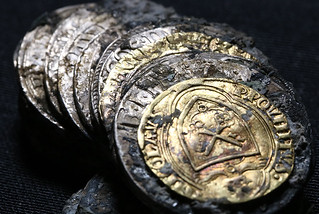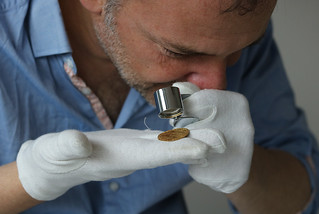
PREV ARTICLE
NEXT ARTICLE
FULL ISSUE
PREV FULL ISSUE
15TH CENTURY COIN FIND IN BURGUNDYA coin find in France sheds light on 15th century trade. -Editor
Consisting of a cemetery in the 4th century AD, the town of Saint Bénigne was integrated into the rest of the city after the 7th century and surrounded by the medieval city wall. The coins were found in a stone house dating to the late 15th or early 16th century. The deposit, which was, unfortunately, damaged by construction in the 20th century, was probably buried under the floor of the house, near a wall. The deposit consists of 34 coins, 10 of which are gold and 24 silver. They were contained in a small bronze box, of which a few remains are preserved. An enameled (green and white) gold pendant accompanied the deposit. Most of the coins were agglomerated together by a crust. Inrap enlisted a specialized laboratory (CREAM Vienne) to detach and clean them. The coins are mostly homogeneous. Chronologically, their year of issue places them in the second half of the 15th century. The oldest is a gold Brabant coin issued between 1432 and 1467. The most recent is a gold coin from pope Innocent VIII, from 1484 to 1492. Most of them seem to have circulated very little. The majority of these coins were issued outside of Burgundy, in the states of the Saint-Empire and from south to north (Brabant, Duchy of Savoy, Palatinate) and the Italian principalities (Milan, Papal States, Ferrara, Venice, etc.). Only one coin from the Kingdom of France was identified (Louis XI). There is a large proportion of Italian coins (in particular, silver Milanese testons of the Sforza).
Ercole II d'Este, Duke of Ferrara, Philip Ist of Palatinate, Pope Innocent VIII, Louis XI, the Doge Nicolo Tron, Philip the Good, Duc de Bourgogne, etc… This deposit resembles a catalog of the great princes of the late Middle Ages. To read the complete article, see:
Wayne Homren, Editor The Numismatic Bibliomania Society is a non-profit organization promoting numismatic literature. See our web site at coinbooks.org. To submit items for publication in The E-Sylum, write to the Editor at this address: whomren@gmail.com To subscribe go to: https://my.binhost.com/lists/listinfo/esylum All Rights Reserved. NBS Home Page Contact the NBS webmaster 
|

